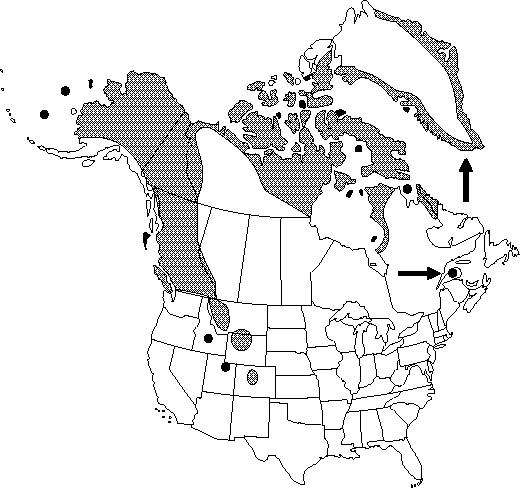Difference between revisions of "Ranunculus pygmaeus"
Fl. Lapp., 157. 1812.
FNA>Volume Importer |
GeoffLevin (talk | contribs) m (Fixed Nfld. and Labr. distribution to match map in printed version.) |
||
| (9 intermediate revisions by 3 users not shown) | |||
| Line 9: | Line 9: | ||
|basionyms= | |basionyms= | ||
|synonyms={{Treatment/ID/Synonym | |synonyms={{Treatment/ID/Synonym | ||
| − | |name= | + | |name=Ranunculus pygmaeus var. langeana |
|authority=Nathorst | |authority=Nathorst | ||
| + | |rank=variety | ||
}} | }} | ||
|hierarchy=Ranunculaceae;Ranunculus;Ranunculus subg. Ranunculus;Ranunculus sect. Epirotes;Ranunculus pygmaeus | |hierarchy=Ranunculaceae;Ranunculus;Ranunculus subg. Ranunculus;Ranunculus sect. Epirotes;Ranunculus pygmaeus | ||
| Line 19: | Line 20: | ||
}}<!-- | }}<!-- | ||
| − | --><span class="statement" id="st- | + | --><span class="statement" id="st-undefined" data-properties=""><b>Stems </b>erect or ascending from short caudices, 0.6-3.5 cm (sometimes longer in fruit), each with 1-2 flowers. <b>Roots</b> slender, 0.1-0.6 mm thick. <b>Basal</b> leaves persistent, blades reniform to transversely elliptic or semicircular, 3-parted or -divided, 0.45-0.9 × 0.6-1.3 cm, at least lateral segments again lobed, base truncate or nearly cordate, margins entire, apex rounded to obtuse. <b>Flowers</b>: pedicels glabrous or pubescent; receptacle glabrous; sepals 2-4 × 1.2-1.6 mm, abaxially sparsely hairy, hairs colorless; petals 5, 1.2-3.5 × 1.1-2.8 mm; nectary scale glabrous. <b>Heads</b> of achenes nearly globose to cylindric, 2.5-7 × 2.5-5 mm; achenes 1-1.2 × 0.8-1.1 mm, glabrous; beak subulate, straight or curved, 0.3-0.7 mm. <b>2n</b> = 16.</span><!-- |
-->{{Treatment/Body | -->{{Treatment/Body | ||
| Line 25: | Line 26: | ||
|habitat=Arctic and alpine meadows and slopes, usually around persistent snow patches | |habitat=Arctic and alpine meadows and slopes, usually around persistent snow patches | ||
|elevation=0-4000 m | |elevation=0-4000 m | ||
| − | |distribution=Greenland;Alta.;B.C.;Nfld.;N.W.T.;Que.;Yukon;Alaska;Colo.;Idaho;Mont.;Utah;Wyo.;Europe (Spitsbergen) | + | |distribution=Greenland;Alta.;B.C.;Nfld. and Labr. (Labr.);N.W.T.;Nunavut;Que.;Yukon;Alaska;Colo.;Idaho;Mont.;Utah;Wyo.;Europe (Spitsbergen). |
| − | |discussion=<p>Ranunculus pygmaeus var. langeana has been described as having deeply divided basal leaves and strongly elongate heads of achenes (at least 5 mm). These characteristics are not well correlated with one another, however, and the variety does not seem natural.</p> | + | |discussion=<p><i>Ranunculus pygmaeus</i> var. langeana has been described as having deeply divided basal leaves and strongly elongate heads of achenes (at least 5 mm). These characteristics are not well correlated with one another, however, and the variety does not seem natural.</p> |
|tables= | |tables= | ||
|references= | |references= | ||
| Line 35: | Line 36: | ||
-->{{#Taxon: | -->{{#Taxon: | ||
name=Ranunculus pygmaeus | name=Ranunculus pygmaeus | ||
| − | |||
|authority=Wahlenberg | |authority=Wahlenberg | ||
|rank=species | |rank=species | ||
|parent rank=section | |parent rank=section | ||
| − | |synonyms= | + | |synonyms=Ranunculus pygmaeus var. langeana |
|basionyms= | |basionyms= | ||
|family=Ranunculaceae | |family=Ranunculaceae | ||
| Line 45: | Line 45: | ||
|habitat=Arctic and alpine meadows and slopes, usually around persistent snow patches | |habitat=Arctic and alpine meadows and slopes, usually around persistent snow patches | ||
|elevation=0-4000 m | |elevation=0-4000 m | ||
| − | |distribution=Greenland;Alta.;B.C.;Nfld.;N.W.T.;Que.;Yukon;Alaska;Colo.;Idaho;Mont.;Utah;Wyo.;Europe (Spitsbergen) | + | |distribution=Greenland;Alta.;B.C.;Nfld. and Labr. (Labr.);N.W.T.;Nunavut;Que.;Yukon;Alaska;Colo.;Idaho;Mont.;Utah;Wyo.;Europe (Spitsbergen). |
|reference=None | |reference=None | ||
|publication title=Fl. Lapp., | |publication title=Fl. Lapp., | ||
|publication year=1812 | |publication year=1812 | ||
|special status= | |special status= | ||
| − | |source xml=https:// | + | |source xml=https://bitbucket.org/aafc-mbb/fna-data-curation/src/2e0870ddd59836b60bcf96646a41e87ea5a5943a/coarse_grained_fna_xml/V3/V3_185.xml |
|genus=Ranunculus | |genus=Ranunculus | ||
|subgenus=Ranunculus subg. Ranunculus | |subgenus=Ranunculus subg. Ranunculus | ||
|section=Ranunculus sect. Epirotes | |section=Ranunculus sect. Epirotes | ||
|species=Ranunculus pygmaeus | |species=Ranunculus pygmaeus | ||
| − | |||
| − | |||
| − | |||
| − | |||
| − | |||
| − | |||
| − | |||
| − | |||
| − | |||
| − | |||
| − | |||
| − | |||
| − | |||
| − | |||
| − | |||
| − | |||
| − | |||
| − | |||
| − | |||
| − | |||
| − | |||
| − | |||
| − | |||
| − | |||
| − | |||
| − | |||
| − | |||
| − | |||
| − | |||
| − | |||
| − | |||
| − | |||
| − | |||
| − | |||
| − | |||
| − | |||
}}<!-- | }}<!-- | ||
-->[[Category:Treatment]][[Category:Ranunculus sect. Epirotes]] | -->[[Category:Treatment]][[Category:Ranunculus sect. Epirotes]] | ||
Latest revision as of 16:10, 29 February 2024
Stems erect or ascending from short caudices, 0.6-3.5 cm (sometimes longer in fruit), each with 1-2 flowers. Roots slender, 0.1-0.6 mm thick. Basal leaves persistent, blades reniform to transversely elliptic or semicircular, 3-parted or -divided, 0.45-0.9 × 0.6-1.3 cm, at least lateral segments again lobed, base truncate or nearly cordate, margins entire, apex rounded to obtuse. Flowers: pedicels glabrous or pubescent; receptacle glabrous; sepals 2-4 × 1.2-1.6 mm, abaxially sparsely hairy, hairs colorless; petals 5, 1.2-3.5 × 1.1-2.8 mm; nectary scale glabrous. Heads of achenes nearly globose to cylindric, 2.5-7 × 2.5-5 mm; achenes 1-1.2 × 0.8-1.1 mm, glabrous; beak subulate, straight or curved, 0.3-0.7 mm. 2n = 16.
Phenology: Flowering summer (Jul–Sep).
Habitat: Arctic and alpine meadows and slopes, usually around persistent snow patches
Elevation: 0-4000 m
Distribution

Greenland, Alta., B.C., Nfld. and Labr. (Labr.), N.W.T., Nunavut, Que., Yukon, Alaska, Colo., Idaho, Mont., Utah, Wyo., Europe (Spitsbergen).
Discussion
Ranunculus pygmaeus var. langeana has been described as having deeply divided basal leaves and strongly elongate heads of achenes (at least 5 mm). These characteristics are not well correlated with one another, however, and the variety does not seem natural.
Selected References
None.